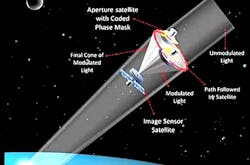Nanosatellite trio could provide astronomical images as sharp as a much larger space telescope
| The proposed SMART (synthetic marginal aperture with revolving telescopes) nanosatellite formation. (Image: Ben-Gurion University) |
An incoherent optical synthetic-aperture technique developed by researchers at Ben-Gurion University (BGU; Beersheba, Israel) can potentially combine the light received by two small separated telescopes in space, which are revolving in circular paths around a common axis, at a third small sensing satellite, resulting in stellar and other astronomical images that have a resolution equal to what would be created by a large optical space telescope -- one with an aperture equal to the separation between the two small satellites.1 At the image-sensing satellite, the two incoming beams of light are sampled a few times per the rotation period of the two telescope satellites, and images are created using the coded aperture holography technique, in which the light is modulated by a pseudorandom coded phase mask.
The technique could lead to very-high-resolution but inexpensive space telescopes (the only disadvantage being that the light-collecting ability of the two small satellites would be far smaller than that of a single large telescope).
"This is an invention that completely changes the costs of space exploration, astronomy, aerial photography, and more," says Angika Bulbul, a BGU Ph.D. candidate under the supervision of BGU professor Joseph Rosen.
To demonstrate the synthetic marginal aperture with revolving telescopes (SMART) system capabilities, the researchers built a miniature laboratory model with a circular array of subapertures to study the image resolution and compare them with full lens imagery.
"Several previous assumptions about long-range photography were incorrect," Bulbul says. "We found that you only need a small part of a telescope lens to obtain quality images. Even by using the perimeter aperture of a lens, as low as 0.43%, we managed to obtain similar image resolution compared to the full aperture area of mirror/lens-based imaging systems. Consequently, we can slash the huge cost, time and material needed for gigantic traditional optical space telescopes with large curved mirrors."
The researchers say that the 0.43% aperture area relative to a full-aperture telescope could be reduced even further in the future without degrading performance (meaning that the same-sized small space telescope pair could be moved further apart to simulate an even larger telescope without any deleterious effects).
Source: https://aabgu.org/new-bgu-system-produces-hi-res-images-at-low-cost/
REFERENCE:
1. Angika Bulbul et al., Optica (2018); https://doi.org/10.1364/optica.5.001607.
